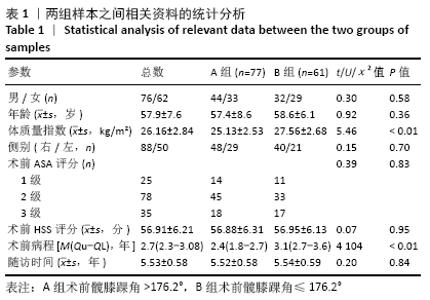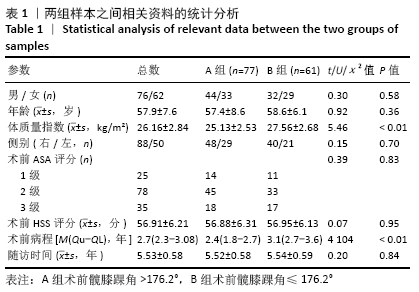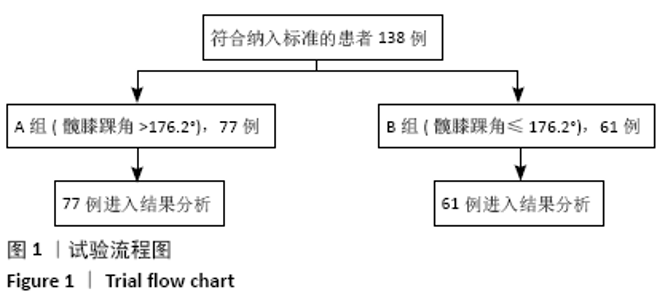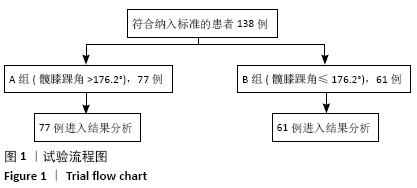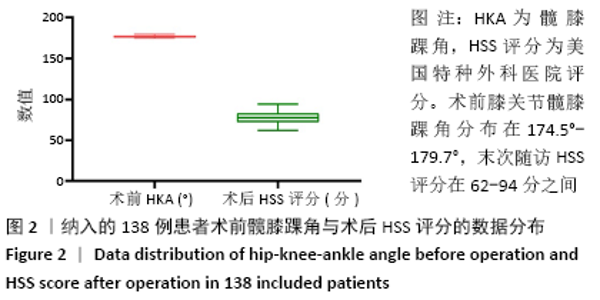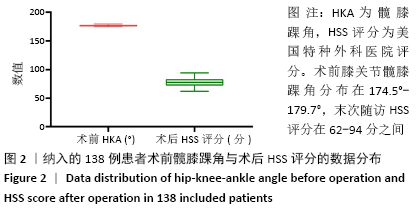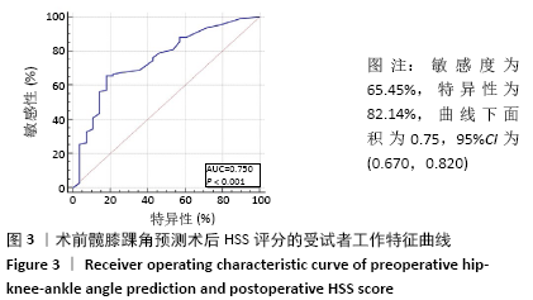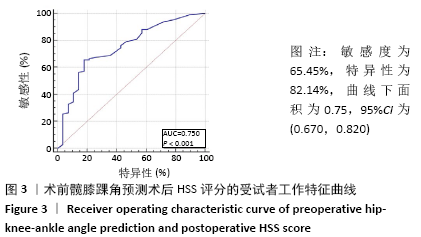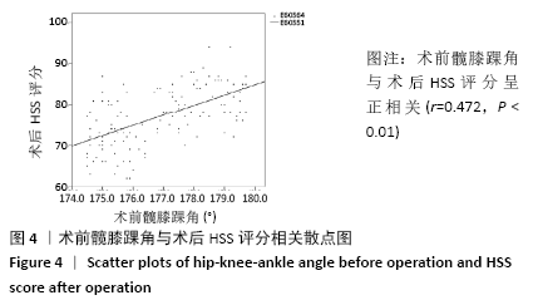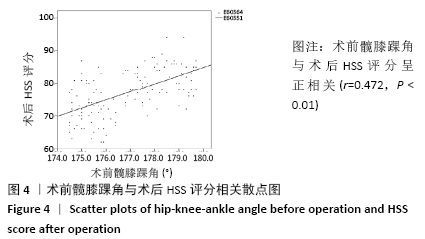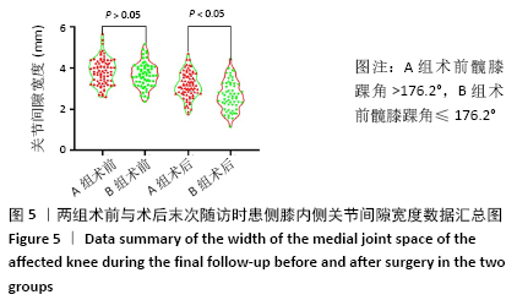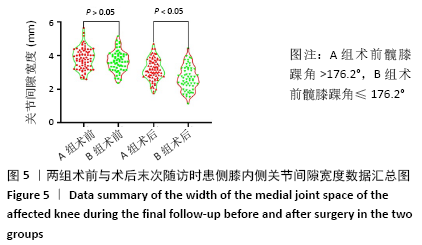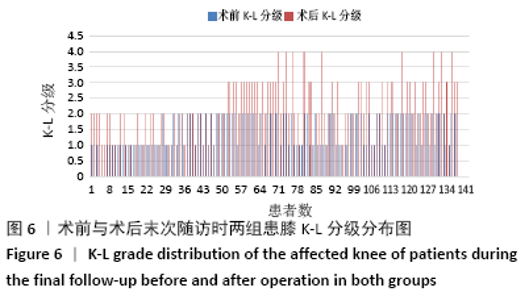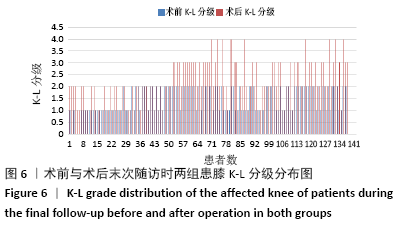Chinese Journal of Tissue Engineering Research ›› 2021, Vol. 25 ›› Issue (21): 3368-3373.doi: 10.3969/j.issn.2095-4344.3862
Previous Articles Next Articles
Imaging evaluation of the hip-knee-ankle angle and osteoarthritis progression before and after partial meniscectomy for degenerative medial meniscus posterior root tear
Peng Chao1, Liu Yunpeng2, Hua Guojun2, Yang Jiaji2, Wang Xingliang2, Wang Xiaolong1
- 1Anhui Medical University, Hefei 230000, Anhui Province, China; 2The 904 Hospital of the Joint Service Support Force of Chinese PLA, Wuxi 214000, Jiangsu Province, China
-
Received:2020-08-18Revised:2020-08-21Accepted:2020-09-26Online:2021-07-28Published:2021-01-23 -
Contact:Liu Yunpeng, Chief physician, The 904 Hospital of the Joint Service Support Force of Chinese PLA, Wuxi 214000, Jiangsu Province, China -
About author:Peng Chao, Master candidate, Anhui Medical University, Hefei 230000, Anhui Province, China -
Supported by:the Science and Technology Development Foundation Project of Wuxi, No. CSE31N1618 (to LYP); the Scientific Research Project of Health and Family Planning Commission of Wuxi, No. Q201772 (to WXL)
CLC Number:
Cite this article
Peng Chao, Liu Yunpeng, Hua Guojun, Yang Jiaji, Wang Xingliang, Wang Xiaolong. Imaging evaluation of the hip-knee-ankle angle and osteoarthritis progression before and after partial meniscectomy for degenerative medial meniscus posterior root tear[J]. Chinese Journal of Tissue Engineering Research, 2021, 25(21): 3368-3373.
share this article
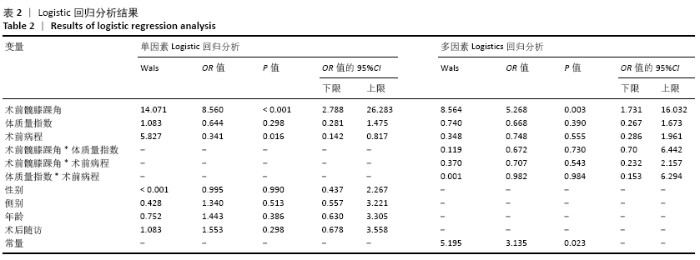
2.6 Logistics回归分析各变量和术后HSS评分之间的相关性 单因素Logistics回归分析结果显示,术前髋膝踝角和术前病程均与术后HSS评分之间存在相关性(P < 0.05),见表2。但结合既往研究结果,依然将体质量指数纳入多因素Logistics回归分析模型中,结果显示只有髋膝踝角是影响术后HSS评分的独立危险因素(P < 0.01)。在多因素Logistics回归分析中引入3个亚变量(体质量指数和术前病程、体质量指数和髋膝踝角、术前病程和髋膝踝角)进行交互作用分析后,结果显示体质量指数、术前病程和髋膝踝角之间不存在交互作用(P > 0.05),即体质量指数和术前病程均不影响髋膝踝角与膝关节骨性关节炎进展之间的相关性,见表2。 "
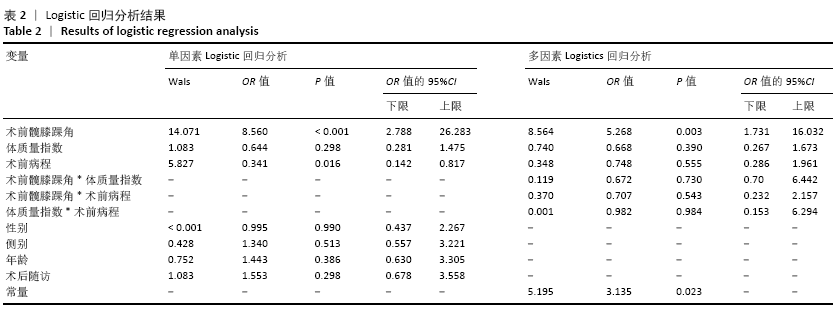
| [1] BIN SI, KIM JM, SHIN SJ. Radial tears of the posterior horn of the medial meniscus. Arthroscopy. 2004;20:373-378. [2] KAPLAN DJ, ALAIA EF, DOLD AP, et al. Increased extrusion and ICRS grades at 2-year follow-up following transtibial medial meniscal root repair evaluated by MRI. Knee Surg Sports Traumatol Arthrosc. 2018;26:2826-2834. [3] KE XI, QIU J, CHEN S, et al. Concurrent arthroscopic meniscal repair during open-wedge high tibial osteotomy is not clinically beneficial for medial meniscus posterior root tears. Knee Surg Sports Traumatol Arthrosc. 2020. doi: 10.1007/s00167-020-06055-9. [4] LEE JH, LIM YJ, KIM KB, et al. Arthroscopic pullout suture repair of posterior root tear of the medial meniscus: radiographic and clinical results with a 2-year follow-up. Arthroscopy. 2009;25:951-958. [5] OKAZAKI Y, FURUMATSU T, SHIMAMURA Y, et al. Time-dependent increase in medial meniscus extrusion after medial meniscus posterior root tear analyzed by using magnetic reso-nance imaging. Knee Surg Relat Res. 2019;31:120-125. [6] KIM SB, HA JK, LEE SW, et al. Medial meniscus root tear refixation: comparison of clinical, radiologic, and arthroscopic findings with medial meniscectomy. Arthroscopy. 2011;27:346-354. [7] BERNARD CD, KENNEDY NI, TAGLIERO AJ, et al. Medial menis-cus posterior root tear treatment: a matched cohort comparison of nonoperative management, partial meniscectomy, and repair. Am J Sports Med. 2020;48(1):128-132. [8] PARK DY, MIN BH, CHOI BH, et al. The degeneration of meniscus roots is accompanied by fbrocartilage formation, which may precede meniscus root tears in osteoarthritic knees. Am J Sports Med. 2015;43:3034-3044. [9] HAN SB, SHETTY GM, LEE DH, et al. Unfavorable results of partial meniscectomy for complete posterior medial meniscus root tear with early osteoarthritis: a 5-to 8-year follow-up study. Arthroscopy. 2010;26:1326-1332. [10] OZKOC G, CIRCI E, GONC U, et al. Radial tears in the root of the posterior horn of the medial meniscus. Knee Surg Sports Traumatol Arthrosc. 2008;16:849-854. [11] KRYCH AJ, JOHNSON NR, MOHAN R, et al. Partial meniscectomy provides no benefit for symp-tomatic degenerative medial meniscus posterior root tears. Knee Surg Sports Traumatol Arthrosc. 2018;26: 1117-1122. [12] LEE BS, BIN SI, KIM JM, et al. Partial meniscectomy for degenerative medial meniscal root tears shows favorable outcomes in well-aligned, nonarthritic knees. Am J Sports Med. 2019;47:606-611. [13] MOATSHE G, CHAHLA J, SLETTE E, et al. Posterior meniscal root injuries. Acta Orthop. 2016;87:452-458. [14] 史俊龙,鹿战,雷宏伟,等.下肢力线在盘状半月板损伤应用的研究进展[J].中国骨伤,2020,33(4):383-387. [15] JOHN R, MORELAND A, LAWRENCE W, et al. Radio graphit analysis of the axial alignment of the lower extremity. J Bone Joint Surg. 1987;11: 745-749. [16] MORELAND JR, BASSETT LW, HANKER GJ. Radiographic analysis of the axial alignment of the lower extremity. J Bone Joint Surgery Am. 1987;69(5):745-749. [17] Hellio Le Graverand MP, Mazzuca S, Duryea J, et al. Radio graphic grading and measurement of joint space width in osteoarthritis. Rheum Dis Clin North Am. 2009;35:485-502. [18] 蒋美超.膝关节单髁置换术影像学及临床疗效评估[D].石家庄:河北医科大学,2011. [19] ALLEN CR, WONG EK, LIVESAY GA, et al. Impor-tance of the medial meniscus in the anterior cruciate ligament deficient knee. J Orthop Res. 2000;18(1):109-115. [20] MUSAHL V, CITAK M, O’LOUGHLIN PF, et al. The effect of medial versus lateral meniscectomy on the stability of the anterior cruciate ligament–deficient knee. Am J Sports Med. 2010;38(8):1591-1597. [21] PAPAGEORGIOU CD, GIL JE, KANAMORI A, et al. The biomechanical interdependence between the anterior cruciate ligament replacement graft and the medial meniscus. Am J Sports Med. 2001;29(2):226-231. [22] SPANG JT, DANG AB, MAZZOCCA A, et al. The effect of medial meniscectomy and meniscal allograft transplantation on knee and anterior cruciate ligament biomechanics. Arthroscopy. 2010;26(2):192-201. [23] ALLAIRE R, MURIUKI M, GILBERTSON L, et al. Biome chanical consequences of a tear of the posterior root of the medial meniscus. Similar to total meniscectomy. J Bone Joint Surg Am. 2008;90:1922-1931. [24] KWAK YH, LEE S, LEE MC, et al. Large meniscus extru-sion ratio is a poor prognostic factor of conservative treatment for medial meniscus posterior root tear. Knee Surg Sports Traumatol Arthrosc. 2018;26:781-786. [25] BHATIA S, LAPRADE CM, ELLMAN MB, et al. Meniscal root tears: signifcance, diagnosis, and treatment. Am J Sports Med. 2014;42:3016-3030. [26] LEE DW, HA JK, KIM JG. Medial meniscus posterior root tear: a comprehensive review. Knee Surg Relat Res. 2014;26:125-134. [27] SHARMA L, SONG J, FELSON DT, et al. The role of knee alignment in disease progression and functional decline in knee osteoarthritis. JAMA. 2001;286:188-195. [28] CHUNG KS, HA JK, YEOM CH, et al. Comparison of clinical and radiologic results between partial meniscectomy and refxation of medial meniscus posterior root tears: a minimum 5-year follow-up. Arthroscopy. 2015;31:1941-1950. [29] FEUCHT MJ, KUHLE J, BODE G, et al. Arthroscopic transtibial pullout repair for posterior medial meniscus root tears: a systematic review of clinical, radiographic, and second-look arthroscopic results. Arthroscopy. 2015;31:1808-1816. [30] CHUNG KS, HA JK, RA HJ, et al. Prognostic factors in the midterm results of pullout fxation for posterior root tears of the medial meniscus. Arthroscopy. 2016;32:1319-1327. [31] BENICHOU OD, HUNTER DJ, NELSON DR, et al. One-year change in radiographic joint space width in patients with unilateral joint space narrowing: data from the osteoarthritis initiative. Arthritis Care Res. 2010;62:924-931. |
| [1] | Hu Kai, Qiao Xiaohong, Zhang Yonghong, Wang Dong, Qin Sihe. Treatment of displaced intra-articular calcaneal fractures with cannulated screws and plates: a meta-analysis of 15 randomized controlled trials [J]. Chinese Journal of Tissue Engineering Research, 2021, 25(9): 1465-1470. |
| [2] | Huang Dengcheng, Wang Zhike, Cao Xuewei. Comparison of the short-term efficacy of extracorporeal shock wave therapy for middle-aged and elderly knee osteoarthritis: a meta-analysis [J]. Chinese Journal of Tissue Engineering Research, 2021, 25(9): 1471-1476. |
| [3] | Xu Feng, Kang Hui, Wei Tanjun, Xi Jintao. Biomechanical analysis of different fixation methods of pedicle screws for thoracolumbar fracture [J]. Chinese Journal of Tissue Engineering Research, 2021, 25(9): 1313-1317. |
| [4] | Jiang Yong, Luo Yi, Ding Yongli, Zhou Yong, Min Li, Tang Fan, Zhang Wenli, Duan Hong, Tu Chongqi. Von Mises stress on the influence of pelvic stability by precise sacral resection and clinical validation [J]. Chinese Journal of Tissue Engineering Research, 2021, 25(9): 1318-1323. |
| [5] | Zhang Tongtong, Wang Zhonghua, Wen Jie, Song Yuxin, Liu Lin. Application of three-dimensional printing model in surgical resection and reconstruction of cervical tumor [J]. Chinese Journal of Tissue Engineering Research, 2021, 25(9): 1335-1339. |
| [6] | Zhang Yu, Tian Shaoqi, Zeng Guobo, Hu Chuan. Risk factors for myocardial infarction following primary total joint arthroplasty [J]. Chinese Journal of Tissue Engineering Research, 2021, 25(9): 1340-1345. |
| [7] | Wei Wei, Li Jian, Huang Linhai, Lan Mindong, Lu Xianwei, Huang Shaodong. Factors affecting fall fear in the first movement of elderly patients after total knee or hip arthroplasty [J]. Chinese Journal of Tissue Engineering Research, 2021, 25(9): 1351-1355. |
| [8] | Wang Jinjun, Deng Zengfa, Liu Kang, He Zhiyong, Yu Xinping, Liang Jianji, Li Chen, Guo Zhouyang. Hemostatic effect and safety of intravenous drip of tranexamic acid combined with topical application of cocktail containing tranexamic acid in total knee arthroplasty [J]. Chinese Journal of Tissue Engineering Research, 2021, 25(9): 1356-1361. |
| [9] | Xiao Guoqing, Liu Xuanze, Yan Yuhao, Zhong Xihong. Influencing factors of knee flexion limitation after total knee arthroplasty with posterior stabilized prostheses [J]. Chinese Journal of Tissue Engineering Research, 2021, 25(9): 1362-1367. |
| [10] | Peng Zhihao, Feng Zongquan, Zou Yonggen, Niu Guoqing, Wu Feng. Relationship of lower limb force line and the progression of lateral compartment arthritis after unicompartmental knee arthroplasty with mobile bearing [J]. Chinese Journal of Tissue Engineering Research, 2021, 25(9): 1368-1374. |
| [11] | Huang Zexiao, Yang Mei, Lin Shiwei, He Heyu. Correlation between the level of serum n-3 polyunsaturated fatty acids and quadriceps weakness in the early stage after total knee arthroplasty [J]. Chinese Journal of Tissue Engineering Research, 2021, 25(9): 1375-1380. |
| [12] | Zhang Chong, Liu Zhiang, Yao Shuaihui, Gao Junsheng, Jiang Yan, Zhang Lu. Safety and effectiveness of topical application of tranexamic acid to reduce drainage of elderly femoral neck fractures after total hip arthroplasty [J]. Chinese Journal of Tissue Engineering Research, 2021, 25(9): 1381-1386. |
| [13] | Wang Haiying, Lü Bing, Li Hui, Wang Shunyi. Posterior lumbar interbody fusion for degenerative lumbar spondylolisthesis: prediction of functional prognosis of patients based on spinopelvic parameters [J]. Chinese Journal of Tissue Engineering Research, 2021, 25(9): 1393-1397. |
| [14] | Lü Zhen, Bai Jinzhu. A prospective study on the application of staged lumbar motion chain rehabilitation based on McKenzie’s technique after lumbar percutaneous transforaminal endoscopic discectomy [J]. Chinese Journal of Tissue Engineering Research, 2021, 25(9): 1398-1403. |
| [15] | Chen Xinmin, Li Wenbiao, Xiong Kaikai, Xiong Xiaoyan, Zheng Liqin, Li Musheng, Zheng Yongze, Lin Ziling. Type A3.3 femoral intertrochanteric fracture with augmented proximal femoral nail anti-rotation in the elderly: finite element analysis of the optimal amount of bone cement [J]. Chinese Journal of Tissue Engineering Research, 2021, 25(9): 1404-1409. |
| Viewed | ||||||
|
Full text |
|
|||||
|
Abstract |
|
|||||
